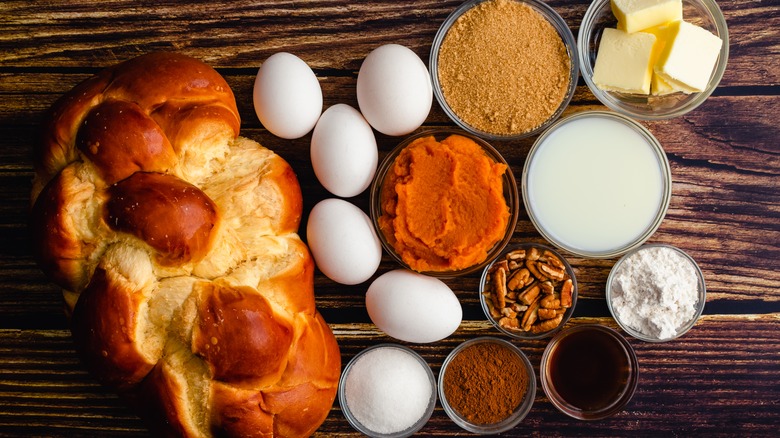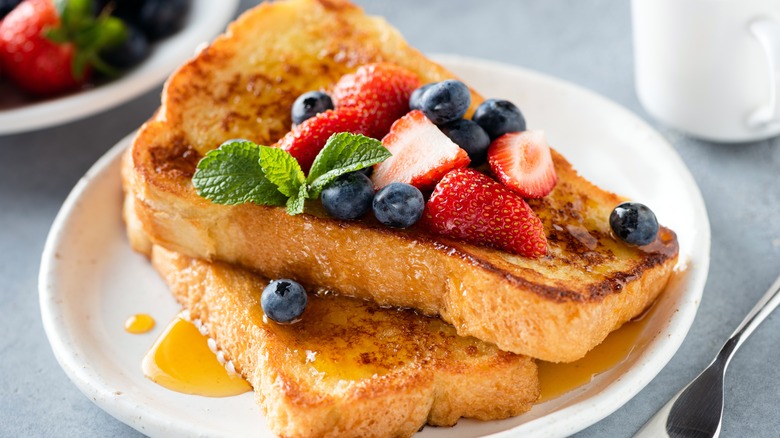Ina Garten's Favorite Bread For French Toast
Several of Ina Garten's cookbooks feature French toast recipes, starting with her 2002 bestseller, "Barefoot Contessa Family Style." While the recipes vary in technique, they all utilize the same bread type. Whether the Barefoot Contessa is cubing the bread to make a baked French toast, preparing a fluffy French toast bread pudding, or soaking thick slices for a more traditional version, her favorite style of bread to use is undoubtedly challah.
Challah is an enriched yeast bread that comes from Eastern Europe. Its braided shape is familiar to Jewish families who enjoy it for Friday evening's Shabbat dinner and during the holidays. It is a slightly sweet, soft bread with a pale yellow color that comes from the high amount of eggs in the dough. Its high-fat content gives the bread its signature squishy but dense texture, making it ideal for French toast since the slices stay intact after soaking in custard.
The finishing eggwash provides the bread with a glossy sheen but eliminates a hard crust that needs to be trimmed before assembling the dish, so each bite has the same fluffy texture. Challah can be found in three-, four-, or six-stranded braids to form a long loaf or coiled into a circle like a French boule. But, use the longer loaf if you want uniform slices of French toast.
Tips for making Ina-worthy French toast
Whether you are serving French toast for breakfast, brunch, or dinner, a bit of planning will deliver the best results. First, start with a whole loaf of challah bread so you can cut thick ½-inch to 1-inch slices. Thinner sandwich bread will work in a pinch but can fall apart more easily and won't deliver the same mouthfeel.
Slice the bread the night before and allow it to dry out on a sheet pan, uncovered. This will enable the bread to soak up the milk and eggs like a sponge so that you can taste the sweetened custard throughout. Since stale bread is the ideal texture for French toast, you can eliminate waste by storing old bread in the freezer when it's too hard to enjoy fresh. It's best to slice the bread before freezing so you can remove a slice or two; plus, it defrosts quicker.
If French toast is more of a spontaneous meal, Ina Garten suggests lightly oven-roasting fresh bread in a 350-degree Fahrenheit oven for five minutes, but thick slices may take a little longer. The bread shouldn't develop color; it should just dry out. This step can be the difference between soggy and crispy-edged French toast.
Finally, fry the custard-soaked bread in butter or oil over medium heat without crowding the pan. This will ensure each slice has enough time for the custard in the bread's center to set before the outside burns.
Other bread choices for French toast
Similar to challah bread, brioche is a butter-rich, egg-based option that is easily substituted for Ina Garten's favorite pick. It's a little sweeter (and decadent) than traditional challah, so you may want to adjust any sweeteners like honey, white sugar, or maple syrup added to the custard. Brioche's small, tender crumb will soak up the custard, making the inside fluffy with a toasted buttery crust. Unfortunately, enriched breads tend to be more expensive and may not be available everywhere, so if you make French toast regularly, there are other options.
Homemade white or country-style white sandwich bread like Pain de Mie offers a neutral backdrop, which is helpful when you want the custard's flavorings or toppings to shine. This is a great option when including citrus zest in the custard or stuffing the French toast. Ideally, sandwich bread should be sliced thick, so avoid thin supermarket options that are better used for tea sandwiches.
When using bread like sourdough or a baguette, drying out the bread in advance is unnecessary for French toast. The bread's firmer texture will hold up to soaking in custard when fresh. Larger crumb varieties like those may take longer to absorb the custard, so be patient and allow it to bathe until the slices feel heavy. If the loaf has a crunchy exterior, trim it. This style of bread works well when preparing overnight French toast since the bread doesn't fall apart while you're sleeping.



